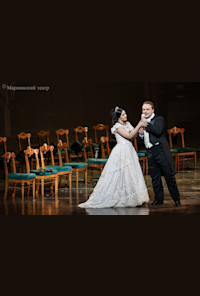

La Traviata (La traviata), Verdi
Μερίδιο
Primorsky Stage of the Mariinsky Theatre (2016/17)Πληροφορίες από καλλιτεχνικό οργανισμό (Επαληθεύτηκε από την Operabase)
Πρωταγωνιστής:
19 Αύγουστος - 08 Μάιος 2016/17 (6 παραστάσεων)
Επισκέψου την ιστοσελίδα|
Ιταλικά
Αγγλικά/Ρωσικά
|
3h 15mins
La traviata by Verdi, Σαβ 05 Νοε 2016, Aπό (2016/2017), Σκηνοθετημένο από Charles Roubaud, Anna Shishkina, αγωγός Anton Torbeev, Valery Gergiev, Pavel Smelkov, Primorsky Stage of the Mariinsky Theatre, Vladivostok, Russia
Προβολή Cast and Crew για 05 Νοε 2016
Conductor
Stage director
Εκμαγείο
Violetta Valéry
(Violetta Valery)
Flora Bervoix
Annina
Alfredo Germont
Giorgio Germont
Gastone
(Gastone de Letorières)
Il barone Douphol
(Barone Douphol)
Il marchese d'Obigny
(Marchese d'Obigny)
Il dottor Grenvil
(Dottore Grenvil)
Giuseppe
Un commissionario
(Commissioner)
Πλήρωμα
Set designer
Costume designer
Lighting designer
Choreographer
Chorus master
Μάθετε περισσότερα για τον συνθέτη
Μάθετε περισσότερα για το μουσικό έργο



